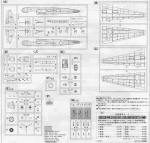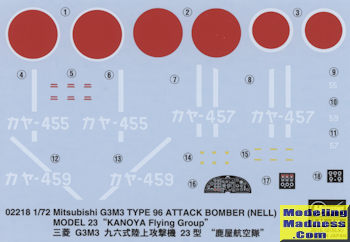
Hasegawa 1/72 G3M3 Type 96 (Nell) "Kanoya Flying Group"
| KIT #: | 02218 |
| PRICE: | 2560 yen (about $23.00) from HLJ |
| DECALS: | Three Options |
| REVIEWER: | Scott Van Aken |
| NOTES: | 2016 Limited reissue |

| HISTORY |
When the Pacific War erupted in 1941, after the Bombing of Pearl Harbor, the G3M was by this time considered to be antiquated but still 3 front-line units (the 22nd to 24th Koku Sentai) were operating a total of 204 G3M2s in four Kokutai (Naval Air Corps) in the central Pacific and of these 54 aircraft from the Takao Kokutai were deployed from Formosa in the opening of the Battle of the Philippines. On the 8th of December 1941, (7th across the International Date Line), G3Ms from the Mihoro Kokutai struck Singapore City from bases in occupied Vietnam as one of many air raids during the Battle of Singapore, resulting in thousands of British and Asiatic civilians dead. Wake Island was similarly bombed by G3Ms from the Chitose Kokutai on the first day of the war, with both civilian and US Navy infrastructure being heavily damaged on the ground.
The G3M was famous for taking part in the sinking of two British battleships with the more advanced Mitsubishi G4M "Betty", on 10 December 1941. "Nells" from the Genzan Kokutai provided important support during the attack on the HMS Prince of Wales and Repulse (Force Z) near the Malayan coast. Prince of Wales and Repulse were the first two battleships ships ever sunk exclusively by air attack while at sea during war.
A G3M of the Mihoro Air Group was involved in a dogfight with a Consolidated PBY Catalina flying boat of No. 205 Squadron RAF near the Anambas Islands on 25 December 1941, in which the Catalina was shot down.
The attack on Darwin, Australia on February 19, 1942, by 188 Japanese aircraft, included 27 G3Ms of the 1. Kokutai (1st Air Group) based at Ambon, in the Dutch East Indies (Indonesia). The "Nells" attacked alongside 27 G4Ms. These bombers followed an 81-strong first wave of Mitsubishi A6M Zero fighters, Aichi D3A dive bombers and Nakajima B5N torpedo bombers.
From 1943, the majority of "Nells" served as coastal patrol aircraft, glider tugs, aircrew and paratroop trainers and for transporting high-ranking officers and VIPs between metropolitan islands, occupied territories and combat fronts until the end of the war.
The difference between the G3M2 and G3M3 is that the latter had more powerful engines and was build solely by Nakajima. Externally, they were identical.
| THE KIT |
 Those
who have been around a while will know that this is not the first 1/72 kit
of this aircraft with LS producing a version way back in the heydays of
modeling during the early 1970s. While not a bad kit, it is crude by
comparison. Even this kit is not ultra new as Hasegawa has been producing
this one sporadically for at least the last ten years. During their 'let us
do a bunch of Japanese twins' period, the Nell was one of those that was
produced.
Those
who have been around a while will know that this is not the first 1/72 kit
of this aircraft with LS producing a version way back in the heydays of
modeling during the early 1970s. While not a bad kit, it is crude by
comparison. Even this kit is not ultra new as Hasegawa has been producing
this one sporadically for at least the last ten years. During their 'let us
do a bunch of Japanese twins' period, the Nell was one of those that was
produced.
Like all Hasegawa kits, the external detailing is superlative. The interior detailing is not too bad either, but somewhat basic. There are decals for the instruments, which is somewhat standard stuff for most 1/72 kits. The cockpit has no sidewall detail with a pair of seats, control wheels and what I guess is a bomb release handle on the floor (since I do not think bombers have a parking brake). Behind the pilot is the bomb aimer's position with a seat and sight along with a pair of bulkheads. The side gunner's position appears to only be able to be built with the guns stowed. This is not true of the upper gun positions. In fact, the forward upper turret can be built either extended or retracted.
One has to decide which markings scheme is to be done about a third of the way through the build and there are notes showing which bits are appropriate for which markings option. The kit can be built with or without prop spinners, with the lower entrance hatch open or closed, with the upper cockpit hatch open or closed and with either a bomb or torpedo load. Apparently Nell did not have a standard bomb bay with doors so all loads are external of sorts.
The clear bits are quite clear so if one can find
an aftermarket set to spice up the interior, it would not go to waste. Nell
had long ailerons similar to what the Ju-87 had in that they protrude below
the lower wing surface. These are molded in place so no worries on attaching
these to the wing.
molded in place so no worries on attaching
these to the wing.
Markings are provided for three similarly painted aircraft, all in dark green over light grey. This was a typical scheme for late war aircraft and all three options are from 1944. They differ only in the tail markings. All are from the Kanoya Naval Flying Group. For the history buff, Kanoya is located on the southern section of the south island of Kyushu and from here, a majority of the kamikaze flights took off for the battles over Okinawa. The decals are very nicely printed and should work just great.
| CONCLUSIONS |
| REFERENCES |
October 2011
If you would like your product reviewed fairly and fairly quickly, please contact me or see other details in the Note to Contributors.
Back to the Previews Index Page